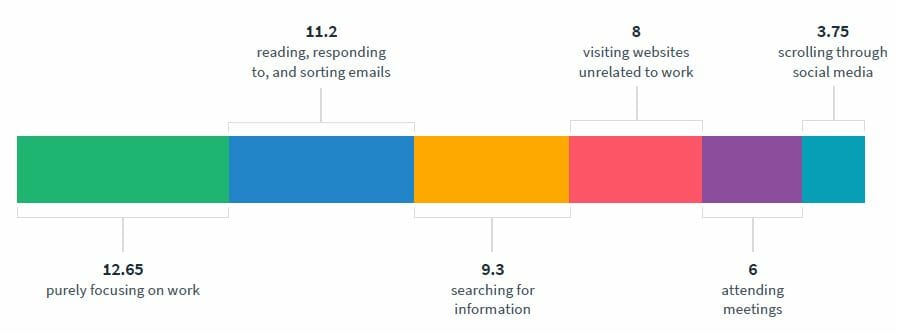Data surrounds everything we do. It’s estimated that last year the world created 33 zettabytes of data. By 2025 the estimate is that will climb to 175ZB. To put that into perspective, a zettabyte is one trillion gigabytes. A decent laptop may hold 1,000GB or 1 terabyte.
A big share of all that data is created by business, so it shouldn’t come as a shock that it has an impact on employee productivity. Almost every aspect of compiling, storing and interpreting business data is adversely affected by the sheer amount of it. Add data chaos to other employee productivity barriers, such as keeping up with emails and meetings, and you have a recipe for an unproductive workplace.
Data is hurting productivity
A survey of U.K. workers suggests they are productive for only about three hours each day. A few years ago, Adobe found white collar workers spending 6 hours a day on email – work and other — alone. People assume because we live in an era that is focused on technology and data, employees must be the most productive they’ve ever been. However, it’s beginning to look like the inverse is true. All these new tools deter us from getting work done.
On the one hand, having access to large amounts of data can help workers be more precise when completing projects. On the other hand, having to manage thousands of data sources can create serious confusion. In fact, in 2012 McKinsey reported that employees spent an average of 9.3 hours per week — 1.8 hours every day — searching for and gathering information. Data can be a business’s greatest resource if managed correctly. However, if data is managed poorly, it can begin to negatively impact workplace productivity.
What else stifles productivity throughout the workday? Here’s a breakdown of how US and UK employees reported spending their time during an average. The chart comes from Formstack’s Workplace Productivity Report that we issued this year:
 These statistics are just the tip of the iceberg when it comes to productivity issues within today’s businesses. Too many processes, paper trails, unreliable data and repetitive tasks are all significant reasons employee productivity is struggling.
These statistics are just the tip of the iceberg when it comes to productivity issues within today’s businesses. Too many processes, paper trails, unreliable data and repetitive tasks are all significant reasons employee productivity is struggling.
Productivity platforms can help
Think about one of the most common workflows for HR managers: onboarding new employees. Typically, lots of documents are needed when onboarding a new employee — tax forms, benefits elections, emergency contacts, direct deposit forms, etc.
Imagine the challenge if multiple employees are hired in various departments at the same time!
Businesses are beginning to take these multi-step processes and turn them into easier-to-manage, single automated workflows via workplace productivity platforms.
The most significant difference between siloed tools with automation capabilities and workplace productivity platforms is a platform’s ability to reach across all departments. From sales and HR to legal and marketing, departments across the company access the same location, centralizing the data, making it possible for businesses to put the data to work for the business as a whole.
A single platform not only offers a cost saving from having multiple programs, it can also save IT departments time by reducing the number of systems that have to be supported. These platforms also tend to be more intuitive for users, thus saving time in training and getting workers to engage with them. The software review site Capterra confirms this ease of use, with most of the leading workplace productivity platforms’ “Ease of Use” scores receiving 4.5 or better out of 5 stars.
Since the mid-1990s, software companies have tried to unify multiple systems into one. Anyone in the workforce during this period knows the all-in-one systems of the time were headache-inducing. But thanks to recent software developments and cloud technology, systems that truly promote productivity are becoming a reality.
